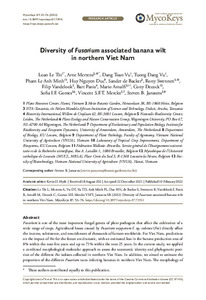| dc.contributor.author | Le Thi, L. |
| dc.contributor.author | Mertens, A. |
| dc.contributor.author | Vu, D.T. |
| dc.contributor.author | Vu, T.D. |
| dc.contributor.author | Anh Minh, P.L. |
| dc.contributor.author | Duc, H.N. |
| dc.contributor.author | de Backer, S. |
| dc.contributor.author | Swennen, R. |
| dc.contributor.author | Vandelook, F. |
| dc.contributor.author | Panis, B. |
| dc.contributor.author | Amalfi, M. |
| dc.contributor.author | Decock, C. |
| dc.contributor.author | Gomes, S.I.F. |
| dc.contributor.author | Merckx, V.S.F. |
| dc.contributor.author | Janssens, S. |
| dc.date.accessioned | 2022-03-21T10:31:20Z |
| dc.date.available | 2022-03-21T10:31:20Z |
| dc.date.issued | 2022 |
| dc.identifier.citation | Le Thi, L., Mertens, A., Vu, D.T., Vu, T.D., Anh Minh, P.L., Duc, H.N., ... & Janssens, S. (2022). Diversity of Fusarium associated banana wilt in northern Viet Nam. MycoKeys, 87, 53-76. |
| dc.identifier.issn | 1314-4057 |
| dc.identifier.uri | https://hdl.handle.net/20.500.12478/7389 |
| dc.description.abstract | Fusarium is one of the most important fungal genera of plant pathogens that affect the cultivation of a wide range of crops. Agricultural losses caused by Fusariumoxysporumf.sp.cubense (Foc) directly affect the income, subsistence, and nourishment of thousands of farmers worldwide. For Viet Nam, predictions on the impact of Foc for the future are dramatic, with an estimated loss in the banana production area of 8% within the next five years and up to 71% within the next 25 years. In the current study, we applied a combined morphological-molecular approach to assess the taxonomic identity and phylogenetic position of the different Foc isolates collected in northern Viet Nam. In addition, we aimed to estimate the proportion of the different Fusarium races infecting bananas in northern Viet Nam. The morphology of the isolates was investigated by growing the collected Fusarium isolates on four distinct nutritious media (PDA, SNA, CLA, and OMA). Molecular phylogenetic relationships were inferred by sequencing partial rpb1, rpb2, and tef1a genes and adding the obtained sequences into a phylogenetic framework. Molecular characterization shows that c. 74% of the Fusarium isolates obtained from infected banana pseudostem tissue belong to F.tardichlamydosporum. Compared to F.tardichlamydosporum, F.odoratissimum accounts for c.10% of the Fusarium wilt in northern Viet Nam, demonstrating that Foc TR4 is not yet a dominant strain in the region. Fusariumcugenangense – considered to cause Race 2 infections among bananas – is only found in c. 10% of the tissue material that was obtained from infected Vietnamese bananas. Additionally, one of the isolates cultured from diseased bananas was phylogenetically not positioned within the F.oxysporum species complex (FOSC), but in contrast, fell within the Fusariumfujikuroi species complex (FFSC). As a result, a possible new pathogen for bananas may have been found. Besides being present on several ABB ‘Tay banana’, F.tardichlamydosporum was also derived from infected tissue of a wild Musalutea, showing the importance of wild bananas as a possible sink for Foc. |
| dc.description.sponsorship | Bill & Melinda Gates Foundation |
| dc.description.sponsorship | Vietnamese National Foundation for Science and Technology Development |
| dc.format.extent | 53-76 |
| dc.language.iso | en |
| dc.subject | Bananas |
| dc.subject | Diseases |
| dc.subject | Fungal Diseases |
| dc.subject | Musa |
| dc.subject | Vietnam |
| dc.title | Diversity of Fusarium associated banana wilt in northern Viet Nam |
| dc.type | Journal Article |
| cg.contributor.crp | Roots, Tubers and Bananas |
| cg.contributor.affiliation | Plant Resources Center, Vietnam |
| cg.contributor.affiliation | Meise Botanic Garden, Belgium |
| cg.contributor.affiliation | International Institute of Tropical Agriculture |
| cg.contributor.affiliation | Bioversity International |
| cg.contributor.affiliation | Naturalis Biodiversity Center, The Netherlands |
| cg.contributor.affiliation | Wageningen University and Research Centre |
| cg.contributor.affiliation | University of Amsterdam |
| cg.contributor.affiliation | Katholieke Universiteit, Leuven |
| cg.contributor.affiliation | Vietnam National University of Agriculture |
| cg.contributor.affiliation | Fédération Wallonie–Bruxelles, Service Général de l’Enseignement Universitaire et de la Recherche Scientifique |
| cg.contributor.affiliation | Mycothèque de l’Université Catholique de Louvain |
| cg.coverage.region | Asia |
| cg.coverage.region | Southeast Asia |
| cg.coverage.country | Vietnam |
| cg.coverage.hub | Eastern Africa Hub |
| cg.researchtheme | Biotech and Plant Breeding |
| cg.identifier.bibtexciteid | LETHI:2022 |
| cg.isijournal | ISI Journal |
| cg.authorship.types | CGIAR and developing country institute |
| cg.iitasubject | Agronomy |
| cg.iitasubject | Banana |
| cg.iitasubject | Food Security |
| cg.iitasubject | Plant Breeding |
| cg.iitasubject | Plant Diseases |
| cg.iitasubject | Plant Production |
| cg.journal | Mycokeys |
| cg.notes | Open Access Article; Published online: 10 Feb 2022 |
| cg.accessibilitystatus | Open Access |
| cg.reviewstatus | Peer Review |
| cg.usagerightslicense | Creative Commons Attribution 4.0 (CC BY 0.0) |
| cg.targetaudience | Scientists |
| cg.identifier.doi | https://dx.doi.org/10.3897/mycokeys.87.72941 |
| cg.iitaauthor.identifier | Rony Swennen: 0000-0002-5258-9043 |
| cg.futureupdate.required | No |
| cg.identifier.volume | 87 |

